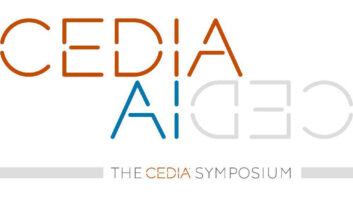ATLANTA
— The custom business is slowly coming back,
and the CEDIA Expo posted modest gains in attendance
to more than 20,700 from last year’s more than 20,000,
and exhibitor-count gains to 453 from 426.
But based on the pace of audio and home-control product
introductions at the Expo, electronic systems contractors
(ESCs) might have headed home wondering if there
had ever been any slowdown.
Installers found a growing selection
of control apps for iPads and Androidbased
devices, more audio components
and multi-room systems with networked
connections to Internet radio sources
and PCs, a proliferation of bezel-less and narrow-bezel
custom speakers for an unobtrusive look, and more custom-
installed subwoofers that reduce their in-wall or inceiling
footprints by firing through tubes.
Installers also found a wide variety of new in-room
speakers, including more thin speakers to match thin TVs
and wireless speakers to eliminate messy speaker-cable
runs. Other new speakers were smaller than ever to appeal
to the decor-conscious.
ESCs also found new brands entering the multi-room
A/V system market and other brands adding systems-integration
capabilities to their multi-room systems. URC and
Emotive, for example, showed their first multi-room audio
systems, and Aton and Legrand integrated control of other
home systems into multi-room audio systems.
In networked products, Sherwood unveiled a $499-suggested
A/V receiver (AVR) with included 802.11n Wi-Fi
adapter, UPnP, access to Internet radio stations through
Reciva and Shoutcast, and streaming of Pandora, Aupeo
and other streaming-music services.
For their part, Pioneer launched its first three Blu-ray
players with ability to stream video-on-demand services, and Denon and Marantz launched their first
compact CD-receivers at a suggested $599 and $699
with built-in Wi-Fi to stream music wirelessly from a networked
PC and access Internet radio stations and music
services. They also sport iPod/iPhone docking.
ClearOne arrived at the CEDIA Expo with four new
products for its NetStreams and Musica multi-room audio
systems. Most add new audio sources — including iPods,
iPads, Internet radio and Bluetooth-equipped cellphones
— to ClearOne systems.
More component-audio products
also turned up with iPod connectivity.
Classe, for example, unveiled its first
audio component with front-panel USBaudio
port to play back music streamed
in digital PCM form from a connected iPod, iPhone, iPad
or USB-connected PC. The CP-800 is expected to be
available in December at less than $6,000.
Rotel also came to the Expo with an iPod/iPhone USB
input on its $3,999-suggested 7.1-channel RSP-1580
preamp processor, a flagship model due in the first quarter of 2011. It joins two other components just shipping
with iPod/iPhone-controlling USB port.
Those two products also stream music from a
UPnP-equipped PC or network-attached storage
(NAS) device.
In architectural speakers, Revel and Triad
Speakers unveiled their first no-bezel models,
and SpeakerCraft (see story below) launched
a new series of bezel-less speakers. For their
part, KEF and Niles launched their first narrowbezel
speakers.
KEF’s selection includes the company’s first
single-speaker-stereo model. The Q series consists
of three two-way models at $250, $300
and $350 each. The C series includes the
single-speaker stereo model and three left-right
models at $180, $225 and for an 8-inch model,
$275 each.
Triad’s first bezel-less, in-ceiling speakers include
four SealedRound speakers with sealed
back box and suggested retails from $250
to $450 each. Four OpenRound open-back
speakers range from $150 to $350 each.
Also for discreet installs, Triad launched two
FlexSub subwoofers, the Mini FlexSub and a
Silver FlexSub, to “completely hide” subwoofer
enclosures in ceilings, closets, basements
and cabinets, the company said. An amplifier
and sub enclosure can be mounted in a crawl
space, attic or cabinet, but sound is delivered
through a short flexible tube.
For unobtrusive in-room placement, multiple
suppliers — including KEF (see TWICE, Sept.
22, p. 1) and Artison — launched thinner speakers designed
to blend in with flat-panel TVs.
Artison replaced its three flat Portrait-series LCR speakers
with new versions that are thinner, lighter and easier to
attach to a flat-panel TV. Like before, the speakers feature
a patented Dual Mono design in which the left speaker
and a right speaker each feature a toed-in center-channel
driver to deliver focused center-channel sound without a
separate center-channel enclosure.
The cabinets of Artison’s updated $2,625/pair Masterpiece,
$1,825/pair Portrait and $1,175/pair Sketch have
been reduced to 2.1 inches (with grille) from 4.2 inches
for attachment to the thinnest 8mm LED-LCD TVs.
In more traditional bookshelf speakers, Atlantic Technology
demonstrated a prototype bookshelf speaker
incorporating Hybrid Pressure Acceleration System (HPAS)
bass technology, which delivers targeted bass performance
with 50 percent smaller cabinets, smaller drivers
and lower costs, the company said.
The prototype AT-2 is only 8.75 inches wide by 15 5/8
inches high by 12.25 inches deep, yet with an interior
acoustic volume of less than 2/3-cubic foot, it delivers
bass response down to 39Hz at -3dB, the company said.
Atlantic Technology expects to begin production early
in 2011 and plans to license out the technology.
In apps, Pioneer showed a planned Android app for
smartphones to control all functions of its Blu-ray players
and AVRs via Wi-Fi, effectively replacing the IR remotes
that come with the Pioneer devices. The Android app,
said to be due soon, also displays a menu of a networked
PC’s audio, video and digital-imaging content. Via the
phones’ DLNA-server capability, consumers will also be
able to push PC content from the PC to the Blu-ray player.
The company also plans to improve its iPhone/Touch app
to control all AVR and Blu-ray features, but the Apple devices
don’t support DLNA-server capability.
For its part, Denon showed an iPod app for the brand’s
four Network 11 AVRs and for a 100th Anniversary AVR.
The app enables control of the products’ functions from a
networked iPad, iPod Touch, or iPhone.
Creston also jumped on the Android bandwagon by
demonstrating a planned Android-based control app on the
7-inch Galaxy Tab cellphone/tablet. The app is due in 30
to 60 days. The company also showed the iPanel, a frame
with hard buttons that attaches to iPads to control Creston
systems via Wi-Fi. Creston also showed an in-wall iPad
dock and tabletop iPad dock to control its systems.













